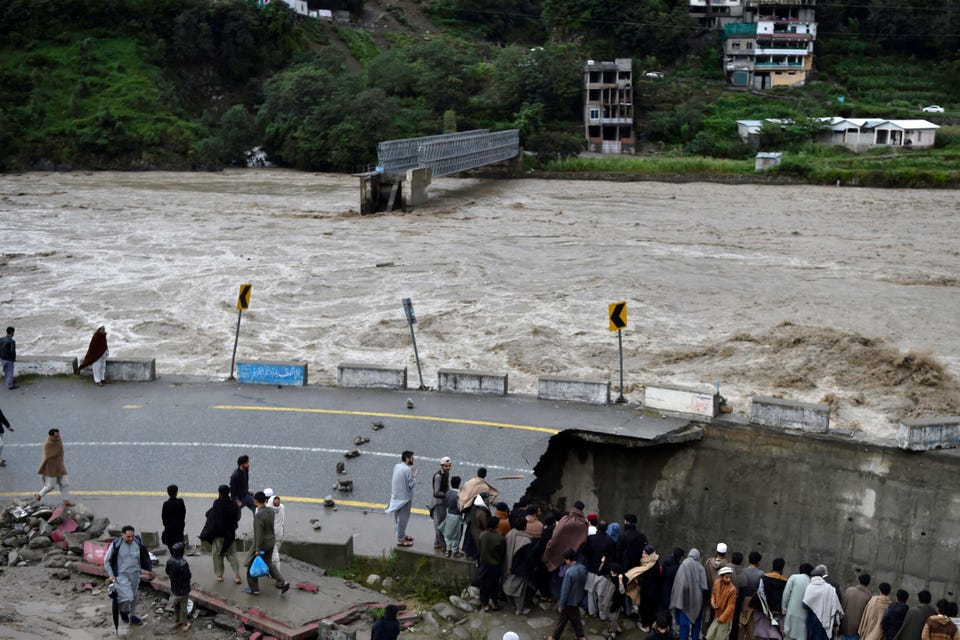Science The Scale Of Pakistan’s Flooding Is Hard To Comprehend Christine Ro Contributor Opinions expressed by Forbes Contributors are their own. I write about science and international development (broadly defined). New! Follow this author to stay notified about their latest stories.
Got it! Sep 1, 2022, 06:15am EDT | New! Click on the conversation bubble to join the conversation Got it! Share to Facebook Share to Twitter Share to Linkedin People gather next to a section of a road damaged by flood waters following heavy monsoon rains in . . .
[+] Madian area in Pakistan’s northern Swat Valley on August 27, 2022. AFP via Getty Images Hira Fatima is 10 years old and has nothing to do. But this isn’t an ordinary situation.
Fatima, together with her parents and four brothers, is staying in a relief camp in Nowshehra, in Pakistan’s Khyber-Pakhtunkhwa province. The family fled their village in Gulistan amidst the devastating flooding that started in July. All they were able to take were some clothes.
Fatima is eager to return home. She has little to do in the camp, she says, except wait in line for food. On 30 August 2022, 10-year-old Hira Fatima takes refuge at the temporary relief camp established at .
. . [+] the Government College No 2 for Management Sciences at Manki Road in Nowshehra, Khyber-Pakhtunkhwa province, Pakistan.
© UNICEF/UN0696521/Zaidi It’s hard to absorb the scale of the devastation. The flooding has affected 33 million people across the country, nearly half of them children. According to UNICEF, more than 1,100 people have died, including over 350 children.
Women, children, and refugees have been especially hard hit. According to MSF, over one-third of the country is under water. The immediate cause was intense monsoon rains, which were almost three times as heavy as the country’s 30-year average.
Country-wide, 116 districts have been affected, but the rain has been even more punishing in certain areas. “In Sindh and Baluchistan province, unprecedented precipitation was recorded,” reports Sher Muhammad, a remote sensing specialist who works with the International Centre for Integrated Mountain Development (ICIMOD). “Nearly 500 mm precipitation (above normal) was recorded in Sindh in August on average.
” “A monsoon on steroids,” is how UN Secretary-General Antonio Guterres has referred to the disaster. But of course the broader culprit is climate change, which has caused glacier melt and havoc with the precipitation cycle. A linked climate disaster is heatwaves, which began in March and accelerated glacier melt and river flow.
Combined with the massive monsoon, flooding became catastrophic. MORE FOR YOU New Research Finds A Connection Between Domestic Violence And These Two Personality Disorders This Scientist Helps Andean Forests And Ecuador’s Women In STEM Exceptional Fossil Preservation Suggests That Discovering Dinosaur DNA May Not Be Impossible Pakistan’s political instability and limited financial resources have made it challenging to apply consistent flood warning systems throughout the country. Geography is also a factor, as Pakistan has the most glaciers of any non-polar region .
And as Muhammad explains, there is a lack of ground observatories in remote mountain valleys. “Due to the mountainous topography, the lag time is too short to respond to such hazards/disasters. Therefore, the early warning system in the mountains needs improvement (installation of the early warning systems preferably in all mountain valleys) for better response and evacuation.
” However, vulnerability doesn’t match up with culpability. Pakistan produces 0. 67% of the world’s CO2 emissions , despite having roughly 2.
8% of the global population. Pakistan’s government has declared a national emergency. The international organizations running emergency appeals for donations include MSF , UNICEF , and Muslim Aid .
But a larger target than individual donations is substantial governmental commitments of climate justice funds, which will be a significant issue at the COP27 climate conference in November. Pakistani relief efforts can’t wait until then. Hunger is certain to be widespread as a result of the flooding and displacement.
According to the International Rescue Committee , over 4 million acres of crops have been damaged. And according to CBS News , over 160 bridges have been damaged. The toll will extend to all parts of the country’s operation: transport, health, sanitation, and more.
In the meantime, millions of people like Fatima will be waiting to rebuild their lives. Check out my website . Christine Ro Editorial Standards Print Reprints & Permissions.
From: forbes
URL: https://www.forbes.com/sites/christinero/2022/09/01/the-scale-of-pakistans-flooding-is-hard-to-comprehend/



